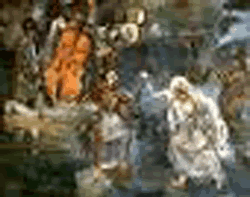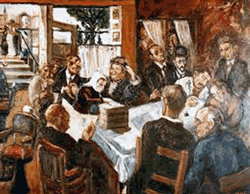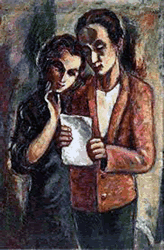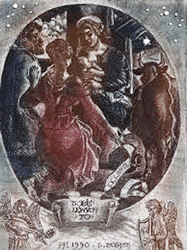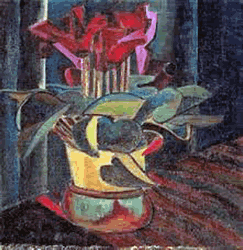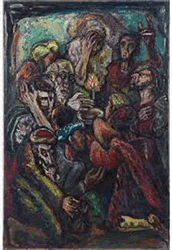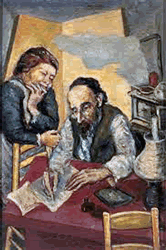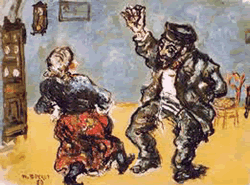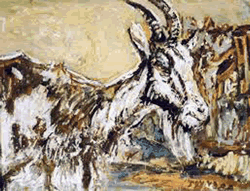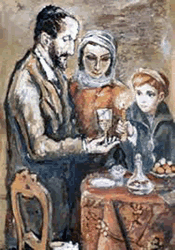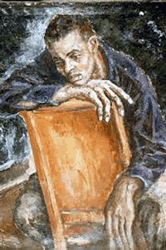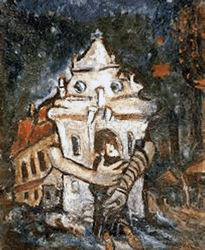The Bekker Family
Raiza Shoshana Meletz married Avraham Menachem Mendel Bekker. Menachem Mendel, born in 1855, was the son of Dov and Shayna Zlata from Vilkomer, Lithuania. Raizeh, daughter of Moshe and Hodes Meletz, gave birth to ten children. The Bekker family was very active in Zionistic endeavors in Vilna. He was a gabbai in the Mahler-Painters Guild shul in Vilna, located on Jews Street, next to the cloister of the Vilna Gaon.
The Bekker Family made significant contributions to the Zionist endeavor during the period of the Second Aliya and in the later development of the State of Israel.
The children of the couple were: Moshe, an agriculturist and early settler of Rishon L'Ziyon, who married Bayla Kravitz. Nissan was ordained to the Rabbinate in Vilna at age 17, but died of tuberculosis at age 20. The four sisters were active members in the Zionist endeavor in their own right: Kayla, married Yisrael Giladi, who was among the founders of the Hashomer Guard organization. Rivka married Akiva Rabinovitz. They were significant activitists in Poalei Zion. Zippora, married Alexander Zaid, the famous guard. Both were founders of the Hashomer. There is a well-known statue of Alexander Zaid on his horse overlooking the Yizrael Valley. Esther, who was a graduate of the first nursing class in Haddasah Hospital, married Meir Kozlovsky. They were also members of the Hashomer
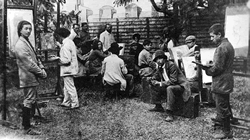
Bekker seated at front with Shatz in background, Bezalel Academy of Art
About their son David Bekker http://davidbekker.com/about.html
David Yona Bekker was born in Vilna, Lithuania in 1897. He studied art in the Antikolsky Academy of Vilna. His father, Avraham Menachem Mendel Bekker, was a painter and mural designer. He encouraged young David in his artistic leanings.
In 1910, David's mother Raizeh (nee Meletz) and her daughter Rivka went to Palestine, joining her eldest son and two of her daughters. David arrived in Palestine in 1911, together with his father and sister. Upon seeing the landscape and beauty of the Holy Land, David was immediately moved to take up pen and paper to capture the scene. The family was re-united in Jerusalem. David Bekker continued his art education in the Bezalel Academy of Art under the founder Prof. Boris Schatz and the artist Abel Pann.
During the First World War, Bekker was stranded in Bulgaria where he had been commissioned to do carvings in wood and metal. He subsequently went to Rumania where he designed coins, medals and ivory carvings for King Carol I. He continued his studies in England, France, and the United States. He studied at the Academy of Fine Arts in Denver, ultimately settling in Chicago. Among his work in the U.S. are ivory carvings that he made for President Warren G. Harding.
Bekker married Esther Kimche-Cohen. They had two children, Alan (Avraham) and Frederika (Shoshana) who died as a child. The marriage ended in divorce. In Chicago, Bekker married Sophie Blevitzky, the daughter of Baruch and Dora (nee Fine). Sophie was both an inspiration and helpmate who recognized the greatness of Bekker's talents. They had three children, Menachem, Dvora (Aviezer) and Alexander (see Family History). David Bekker died in Chicago in 1956 and is buried next to his wife, Sophie, in Petach Tikva, Israel.
Bekker's work was influenced by Jewish themes, tradition and the history of the Jewish people. His works also depict Russian and American life. He was a master of composition. Bekker was a prolific artist who produced and exhibited paintings, woodcuts, etchings and stained glass windows. He was not only creative in various media but his style was rich and varied as well. His work expresses great emotion, depth and movement in a poetic and mystical manner.
Jewish Art: An Illustrated History (Roth C. (1971), Revised edition by Bezalel Narkiss, London: Valentine, Mitchell)
In this book, Cecil Roth describes David Bekker's work as follows: "Bekker's paintings have a quality of line and volume that reveals his experience as a sculptor and designer of medals; his styles vary from the "Jewish populism" of his native Vilna to a kind of Palestinian Hassidic art, analogous to that of Frenel and similarly inspired by visits to Safed. In addition, Bekker has assimilated in the traditional Romantic style a certain liberating influence of the major Jewish painters of Paris and the basic Realism of the Chicago school. His faith in his own mission as spokesman for the artistic aspirations of traditional Jewry at large has helped him integrate these conflicting influences in works such as Rabbi Elimelech, which interpret traditional folklore in as personal a manner as Chagall or Ryback."
Exhibitions
National Gallery of Prints, Washington, DC
Art Institute of Chicago, 1940-1942
Museums in the former USSR
Hillel House, University of Illinois, 1965
Bet Yad L'Banim, Petach Tikva, Israel, 1978
Heichal Shlomo Art Museum, Jerusalem, 2009
Identity and Inspiration
In the book Art of Today, Bekker reveals his identity and his inspiration: "As a descendant of the persecuted Jewish people, branded with a yellow badge of humiliation and rendered impervious to the onslaughts of an antagonistic world by a soul which has never surrendered, I feel impelled to give form in my work to pathos, sorrow, strife and triumphant joy."
In the Jewish Post, May 10, 1946, Bekker is quoted by Efraim Rosenzweig on the subject of Jewish artists and their work: "If there is any mood in the work of most Jewish artists, it is that of sadness. But the mood is visible if and when the artist does not suppress what he actually feels. The true function of the artist is to speak the truth of his mind and his heart. This is impossible where a man suppresses his real feelings in order to improve himself commercially. The artist not only portrays himself but that of his generation as well. I turn back to my childhood and youth; it is like the reconstruction of a dream. There is historical value there too for the paintings are the visible record of a lost world."
Awards
Three first prizes, Bezalel Art School, Jerusalem - 1911, 1912
Second Prize, Ivory Carving, Colorado State Fair - 1923
Hon. Mention, Jewish Women's Art Club - 1933
Covenant Club, Chicago - 1936
Martin B. Cahn Prize for painting, The Cabalist, 53rd annual exhibition of American painting - 1942
Honorary Mention, 21st International Exhibition of Water Colors, A Jewish Lullaby - 1942
Books
Myths and Moods
In Two Worlds
Community and Cultural Activities
Co-Founder, League of Jewish Artists of Chicago
Art Teacher, Hull House, Chicago
Exhibitions
Identity & Inspiration
Awards, Books, Activities
Jewish Life and Folklore
General Scenes
Biblical Themes
Stained Glass Windows
Historical Photos
Photos of the Artist
Family History
Avraham Menachem Mendel and Raizeh Meltzer Bekker
David Yona Bekker was the youngest son of Raiza Shoshana Meletz and Avraham Menachem Mendel Bekker. Menachem Mendel, born in 1855, was the son of Dov and Shayna Zlata from Vilkomer, Lithuania. Raizeh, daughter of Moshe and Hodes Meletz, gave birth to ten children. The Bekker family was very active in Zionistic endeavors in Vilna. He was a gabbai in the Mahler-Painters Guild shul in Vilna, located on Jews Street, next to the cloister of the Vilna Gaon.
The Bekker Family made significant contributions to the Zionist endeavor during the period of the Second Aliya and in the later development of the State of Israel.
The children of the couple were: Moshe, an agriculturist and early settler of Rishon L'Ziyon, who married Bayla Kravitz. Nissan was ordained to the Rabbinate in Vilna at age 17, but died of tuberculosis at age 20. The four sisters were active members in the Zionist endeavor in their own right: Kayla, married Yisrael Giladi, who was among the founders of the Hashomer Guard organization. Rivka married Akiva Rabinovitz. They were significant activitists in Poalei Zion. Zippora, married Alexander Zaid, the famous guard. Both were founders of the Hashomer. There is a well-known statue of Alexander Zaid on his horse overlooking the Yizrael Valley. Esther, who was a graduate of the first nursing class in Haddasah Hospital, married Meir Kozlovsky. They were also members of the Hashomer organization. Perla died at the age of five months, shortly after the death of Nissan. David Yona and his twin sister Kreina Shayna, who did not survive infancy.
Moshe and Bayla were the first of the family to immigrate to Palestine. They lived in Har Tuv where Moshe managed the Goldberg Farm. Two of the older Bekker sisters, Kayla (Giladi) and Zippora (Zaid), immigrated to Palestine in 1907. In 1910, David's mother Raizeh and sister Rivka also immigrated to Palestine, where Rivka married Akiva Rabinovitz.
In 1911, David arrived in Palestine with his father Menachem Mendel and his sister Esther, who was engaged to marry her fiance in Jerusalem. David began his studies in the newly established Bezalel Academy of Art where he studied under Boris Schatz and Abel Pann.
In March 1914, to the great dismay of her family, Esther's fiance broke off the engagement and married another woman. In an impetuous act, by accident or design, David wounded the former fiance, who fortunately recovered.
As a result, David fled Palestine, only returning for a short period around 1919-20. He subsequently began a long journey, eventually arriving in America. He never again saw his family.
Avraham Menachem Mendel brought with him his talent and craft as a specialty house painter of murals and stencils. This was a tradition which had begun in synagogues in Europe and was brought to Eretz Yisrael in the 18th-19th century. Such decorations of ornamental stencils were created for public buildings and for homes of wealthy people. The designs included allegories, the Twelve Tribes, fora and fauna of the Bible and landscapes of religious sites in the Holy Land. Special methods were neeed for the high walls and ceilings and special paints were used which would stand the test of time and weather.
In 1924, Avraham Menachem Mendel Bekker established a painter's guild co-operative (see photo). He and Shmuel Melnick were contemporary competitors. Bekker was a full-fledged member of the Plitei Russia Synagogue in Jerualem for refugees from Russia. His wife Raizeh was a model of charity and social conscience. She gathered many of the homeless and orphaned children of Jerusalem to her home and provided them with food, love and shelter. These children were called "the children of Raizeh" by the people in the neighborhood. Raizeh also saved money from the family's meager income and sent food and cash to the needy.
Menachem Mendel and Raizeh died in 1926 within three months of each other. They were buried in the Mount of Olives Cemetery. Nothing remained of Menachem Mendel's tombstone. Only a portion of Raizeh's tombstone remained undesecrated and was found by Batya (a great-granddaugher) and her husband, Micha Carmon many years after the Six Day War. The two tombstones were restored by their descendents.
-
Eilat Gordin Levitan
